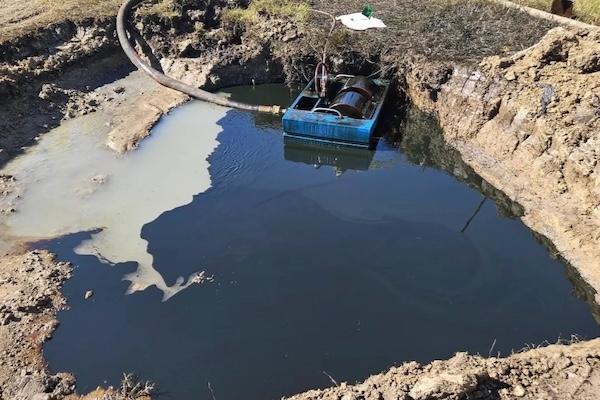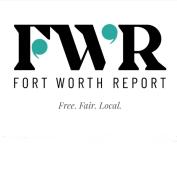
The Environmental Protection Agency and Fort Worth officials reported 2,600 barrels of crude oil from a transmission line leaked in north Arlington on May 6, 2025. Courtesy of Environmental Protection Agency.
BY NICOLE LOPEZ, FORT WORTH REPORT
This article first appeared on Fort Worth Report and is republished here under a Creative Commons Attribution-NoDerivatives 4.0 International License.
The recent closure of Fort Worth’s Village Creek Drying Beds to the public has left some North Texans devastated, particularly those who appreciate the surrounding natural areas, including a trail, and the wildlife that live there.
“This has been a cherished location for local bird-watchers for about 40 years,” said Evan Mistur, a University of Texas at Arlington public affairs professor. “It’s one of the, if not the best, places for bird-watching in DFW.”
Fort Worth officials closed the wastewater system’s drying beds — a simple way to remove moisture from sludge — in May, as they are now being used to store waste-activated sludge used in response to an Arlington oil leak earlier this year.
Both city leaders and federal officials ultimately determined the oil leak posed no environmental or public health risks, according to water department spokesperson Mary Gugliuzza and the EPA’s report. However, in an effort to protect public health and safety and city employees, public access to the drying beds is currently prohibited.
As city officials continue the treatment process, they will assess the possibility of reopening the drying beds to wildlife groups and residents, said Gugliuzza.
Meanwhile, residents question how sewage sludge being stored in the drying beds could impact wildlife.
“We want to make sure that the legal minimum, at least, is being done, to make sure that birds aren’t being damaged and fouled up in this oily mess,” Mistur said.
2,600 BARRELS OF CRUDE OIL LEAKED
On May 6, the Environmental Protection Agency was notified that 20 barrels worth of crude oil had leaked through an Arlington transmission line, ultimately entering a Fort Worth municipal sewer line.
The leak from the transmission line, owned and operated by Energy Transfer, reportedly occurred just before the intersection of West Division Street and Green Oaks Boulevard, just north of Lake Arlington.
The affected sewer line runs to the Village Creek Water Reclamation Facility, where wastewater is treated by the city of Fort Worth.
By May 7, the EPA’s National Response Center reported 2,600 barrels of oil had leaked. Arlington officials, the U.S. Pipeline and Hazardous Materials Safety Administration and Energy Transfer representatives also responded. The Texas Commission on Environmental Quality was informed of the leak. The Texas Parks and Wildlife Department reached out to Fort Worth officials to inquire whether mitigation assistance was needed.

Most of the leaked oil was contained within the Village Creek treatment plant and was safely removed by environmental contractors, Gugliuzza said in a statement. The contained oil was then transported to one of the oil company’s facilities.
“We coordinated closely with the Fort Worth Water Department on all cleanup and repair efforts related to our pipeline and their efforts to repair a nearby wastewater pipeline that had been previously damaged (unrelated to this incident),” said Energy Transfer spokesperson Jeff Tieszen.
Small amounts of residual oil remained in the city’s wastewater treatment system, which “disrupted our biological treatment process,” said Gugliuzza.
The oil affected beneficial microbes — also known as biomass or activated/waste activated sludge — which play a critical role in removing soluble organics found in domestic wastewater, Gugliuzza added.
The affected sewage sludge is being stored at the Village Creek site for air drying before the biomass is disposed of. Owned by the city of Fort Worth, the drying beds are used and permitted for wastewater and biosolid treatment as needed.
“We recognize that the sludge drying beds have long been a point of interest, especially for bird-watchers, as the area is a well-known habitat for migrating birds,” said Gugliuzza.“However, after reviewing safety protocols, we determined that allowing public access to this part of the facility created significant risk to the city.”
NO THREAT IDENTIFIED, OFFICIALS SAY
While officials with the EPA and the cities of Fort Worth and Arlington determined the oil leakage posed no threat to the public, residents remain concerned about how the sludge could affect wildlife, particularly the migratory birds that largely inhabit the area, Mistur said.

Robert Neill, a retired biology professor who taught at the University of Texas at Arlington, hosted field trips at the drying beds during his tenure, describing them as a historic hot spot for hundreds of bird species.
If minimal deposits of oil are present in the affected sewage sludge, it could lead to various health issues for birds involving their reproductive and immune systems and could cause deformities, said Neill.
“Let’s say that maybe the birds are coming through and they eat some of the insects or larva that are getting concentrated in those organisms … that’s going to create some of those problems,” said Neill.
Gugliuzza says the sludge is not to be confused with liquid oil.
“It is waste-activated sludge (biomass) that may have some oil that made it through part of the treatment process,” Gugliuzza said.
Fort Worth officials have not observed any issues with wildlife at the drying beds, Gugliuzza added.
The EPA and the water department also found no oil deposits in the treated sewage discharged into the Trinity River, where the Village Creek treatment plant is permitted to dispose of treated wastewater.
As for Lake Arlington, which sits just below the site of the oil leakage, it can be hard to know if any oil entered the water, unless samples are taken for testing, Neill said.
Arlington officials determined there was no direct impact to the city’s waterways or water infrastructure, city spokesperson Susan Schrock said in a statement.

DEMANDING SOLUTIONS
Wildlife groups from across Dallas-Fort Worth have visited the drying beds for 48 years, said Colby Ayers, a bird-watcher of 20 years. The Fort Worth Audubon Society actively used the site for nature walks and bird-watching.
The group has had to cancel monthly wildlife activities in the Village Creek area, society member Michael Francis said.
“It’s a big deal. Some people are actually going through grief because they were so used to it, and they love it so much,” Francis said.
While Francis also values the area, he applauds Fort Worth leaders for how they’ve responded to the oil leakage and the usage of the drying beds.
“It’s been our privilege to use it for a long time,” Francis said. “The city is responding in a good way.”
Since May, the area has been fenced off with signage, prohibiting public access. Ayers understands the closure comes out of a concern for safety. However, he fears the public may not be able to access the area again in the future.
“It just feels like it’s a done deal,” he said.
At Ayers’ request, the water department in previous years has pumped water into the ponds surrounding the drying beds as a courtesy to the birds. The storage of the impacted sludge eliminates that possibility, said Ayers.
“Wildlife will be impacted regardless of the sludge,” Ayers said. “I won’t be there to see if there is any water, everyone is locked out, and there will be no one looking out for the wildlife.”
Ayers, among several other residents, reached out to Mayor Mattie Parker and City Council members, including Deborah Peoples — whose district includes the treatment plant and the drying beds — but have yet to hear back, he said.
“We wish and hope that the city would just provide us with more reassurance that, ‘Yes, once we clean this up, yes, we will allow people back,’” Ayers said. “I don’t think the city realizes how many people come to Village Creek.”
Peoples did not respond to the Fort Worth Report’s requests for comment.
City leaders intend to repair fence lines and look into secure access gates as staff will be actively hauling to and from the drying beds, Gugliuzza said. The city is also looking into solutions to partially open the drying beds to the public.
“We will investigate whether there is an opportunity for limited and temporary access to wildlife groups, which will involve the city’s law and risk management staff,” Gugliuzza said.
Ayers is now demanding Fort Worth leaders find a solution that allows public access to the drying bed with help from a petition. He plans to take the petition to City Council.
“It’s just a very sad and unfortunate situation. I think more transparency would help.”
Nicole Lopez is the environment reporter for the Fort Worth Report. Contact her at nicole.lopez@fortworthreport.org.
RELATED ARTICLES
Fort Worth water department cleaning sewage contaminated by Arlington oil spill
